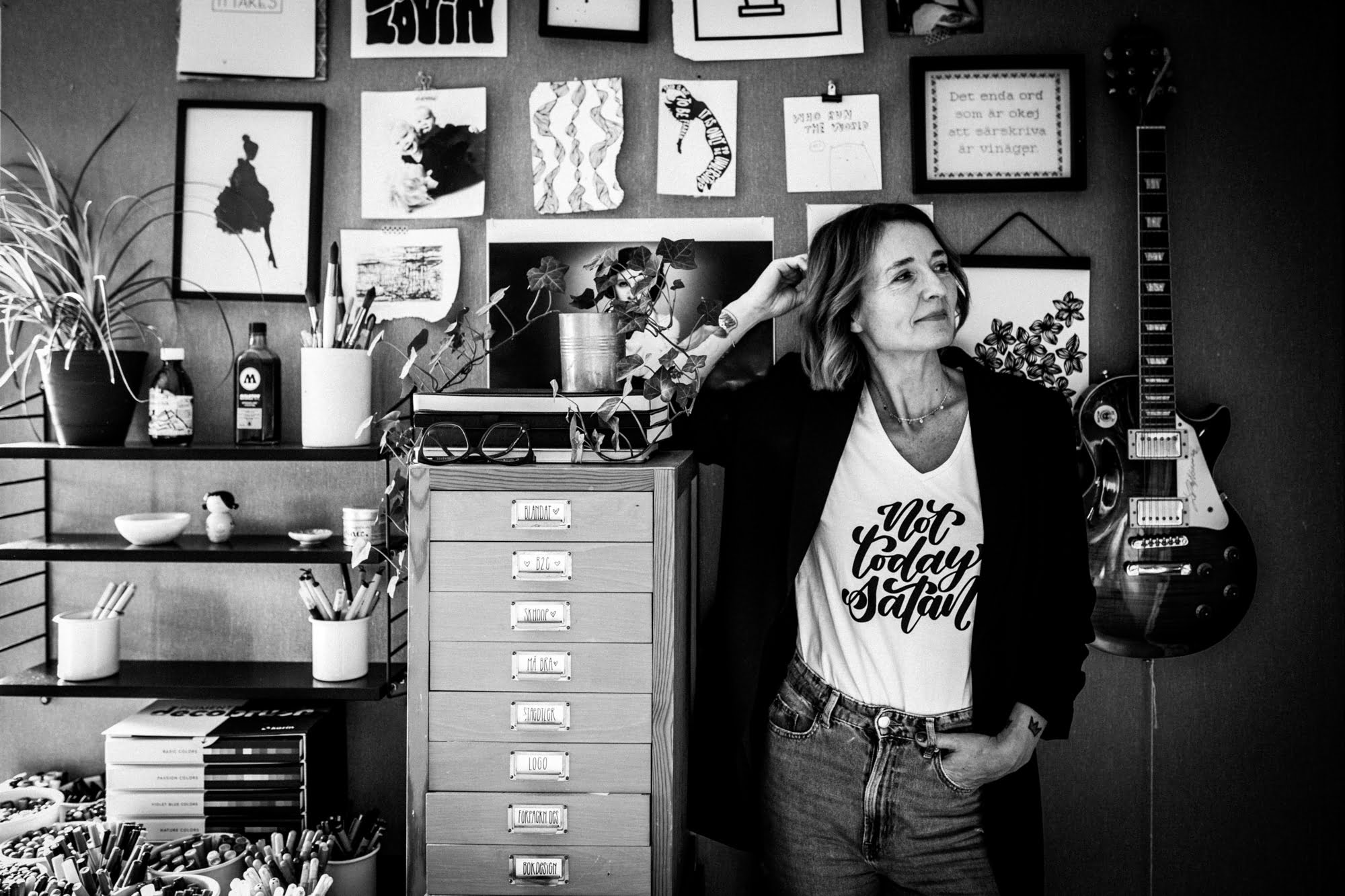This is how I work – from idea to finished original.
Design is magic! Social media and portfolios show what people have created, the finished product and perhaps how it is used. But how did it come about? Somewhere it started with a need (the customer’s) and then an idea (yours), right? And how did it become a finished and suitable graphic design?

Before we start
Here I describe what my process (usually) looks like when I work on behalf of clients. This is just an overview of the creative side. Agreement, license, what is included, deadline, rights and when and how much you will be paid etc. is of course very important, and I can write more about that another time, but it should be down in a quote that becomes an order confirmation that is approved before you start. Here I stick to the creative process and communication with the client to come up with a result that we are both happy with. And: if you expect the job to take three weeks, write four. Anything below that is a bonus.
Before I started lettering, I had not worked in a creative field, nor as a self-employed person, so I had zero experience in those areas. BUT I had worked on the buyer’s side, i.e. with the purchase of the kind of services I sell, and also with photographers, copywriters, stylists, etc. and I have benefited greatly from that. It makes it easier for me to understand how the customer thinks, and maybe ask the right questions if I don’t – and that’s worth a lot.
The brief
It all starts with the brief. The better the brief, the more likely everyone will be happy and your job will go more smoothly. (Read more about what a brief is here). If you don’t do the formal version, make sure you are very careful to find keywords in the customer’s documentation. Some good old-fashioned customer research may also be in order to get a grip on the brand, vision and values that you are about to develop or supplement. Also be sure to get the customer’s approval on your compilation before you start. If you don’t know clearly who they are and what they need, it is much more difficult to get it right.
Getting started
And first, the easiest and hardest thing to do: Start! It is easy to procrastinate, especially if the deadline is far away. DON’T. Stress is bad for creativity. Have the discipline to START on the day you have planned. It’s difficult and hard in the beginning, everything is uncertain and you don’t know how to figure it out and it just feels like UGH why did I even take this job, I know, but the only thing that helps is to grab the proverbial bull by the horns (gah, who even grabs a bull’s HORN? I really need to come up with a better and less tired metaphor here).
But horn number one is NOT to start writing down all the ideas that may have popped up in your head, nope. Instead, you should start by collecting more ammunition:
Do your research, gather ideas
Check similar industries/products to get an idea but don’t get stuck there. Look at similar brands and products, check out the use case, target audience and scroll through your inspiration bank. I usually make a mood board with important keywords and images that frame my work. It doesn’t take long to make, but it helps me in the whole creative process – it generates ideas and makes sure I don’t make mistakes.
Draw
Then I start with the fun and sometimes difficult part: sketching. I often make a literal frame for my sketch – if I know that the logo/image should be a certain shape, I sketch within it from the beginning. Working with quick sketches within a given framework (so-called thumbnails) allows me to quickly get an idea of whether or not it holds up. I am looking at the hierarchy, and roughly at the style, but I am not going into details yet. Instead, I make many! More than I think and more than I want and think I can. The best can come out on paper as No. 18, for example, so it’s silly to give up too soon.
Here it is very easy to get excited about one of those thumbnails and start drawing on it with all the details and colors that I see in front of me. But I don’t. Instead, I run the module called:
Let shit go and go to sleep
I conjure up my inner big dick, drop everything and walk away. Difficult as hell, but I trust that if an idea is really good, it will stay in my head the next day as well.
Once a number of hours have passed, including enough of them involving sleep, it’s time to pick it up again. I try to look with new eyes, as if I haven’t seen the thumbnails before. Which ones would be good to work on? Check with the mood board/brief. Do they hold? Well, okay. Pick a bunch, drop the rest. Sketch them out a bit bigger and pay more attention to details, style, illustrations, etc. Then I break again. Go for a long walk, sleep or do something else entirely. Don’t get stuck in drawing, dare to leave. I can’t count the number of times I’ve come up with the best ideas on how to proceed once I’m out of the drawing bubble.
And one more thing about creation (enter, another tired cliché):
Kill your darlings
It is less fun but all the more necessary. The brain’s lowest creative fruit is to do something that you have done before, that you know and that is easy. Be careful with this when working for clients. It’s not your product, it’s theirs. Keep an eye on the mood board and chop up your own signature stuff with a frenzy – you can do better than that.
Sending proofs
When it’s time to send proposals to the client, I have done so in different ways. Sometimes, if it’s a customer with good ordering skills, I can send my pencil sketches straight off, with my scribbled comments. But often I choose one, two or max three that I digitize and work out a little extra – in fact, I usually only send one proposal nowadays. It’s the very best I’ve created and what I consider to be the best match for the client’s data and needs. I can then spend quite a lot of time making it look finished, including mockups, which makes it much easier for the customer to assess how it will work in different contexts. It’s also important that you don’t just send the image, but clearly state your thinking, the parameters you took into account and the function of the different details and elements. I can’t stress enough the value of doing this to ensure a smooth process and a final product that everyone likes.
Proofreading turns
The number of corrections should be stipulated in the quote or order confirmation, so that both you and the customer don’t send a lot of suggestions or feedback (which at this stage results in a lot of work and many versions). There is, of course, a risk of negative feedback: maybe it’s not what the customer wants, maybe you’ve misunderstood each other, or maybe the customer can’t see why you did what you did. Communication is the blood supply in a process like this, if it’s cut off nothing will be good, so do what you can to ensure good circulation. Explain clearly and nicely. The customer decides, don’t forget that. If you have suggestions or objections to the customer’s views, you can certainly share them, but keep in mind that they are only suggestions. The most important thing is that you help the customer create what they need, be tactful with your own objections.

And finally
Before sending the final version, double-check everything. Are all formats included, all versions, mockups, color schemes and instructions? It sounds silly to point this out, but there have been several times when, in my eagerness to finish something, I’ve run a little too fast and missed something here, and that’s fine, just annoying.
Summary
So, to summarize what I do during the day, I communicate with customers and do some drawing in between. Like this. Listening and telling stories with the aim of making the customer happy is super important. Then:
- Provide feedback by explaining your thinking, the parameters you are working with and why you did what you did.
- Be clear.
- Feel free to use a bulleted list.
- Give yourself a generous amount of time.
- Always respond/feedback when you say you will. If you are delayed, give head’s up.
- Feel free to be nice and funny (you are your brand, don’t forget that), but keep your eyes on the prize. The project should be communicated just as it should be created: efficiently and clearly, without rambling and unnecessary words.
Bonus
Once you’ve finished, satisfied the customer and got your money, it’s easy to just move on to the next job and forget all about it. Don’t. Get in touch after a few months to check the outcome – how did the launch go, what did the customer think, and what did the customers think? Do you need to add anything? This is important for two reasons: first, it’s fun for you to find out and can give you a big boost, and second, it’s a sign of responsibility and an opportunity for additional sales. You also make sure you are top of mind with your customer. Acquiring new customers is hard – selling new jobs to old customers is a much lower threshold, don’t forget.
And if you want to learn more about the creative process of real professionals, I recommend some browsing through these gems.
In Progress by Jessica Hische
The Golden Secrets of Lettering by Martina Flor
Made by James by James Martin
Hope you found this helpful? Keep in mind that you can always contact me with comments, questions or suggestions on what to write about. My inbox door is open!


